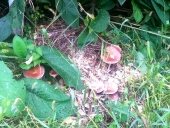
 2
2





 2
2




Some places need to be wild
 1
1




Eric Hanson wrote:C Rogers,
Well, that is quite a list, but my personal choice for mushroom beginners is the wine cap. Its like having training wheels for growing mushrooms.
But first a question: Do you plan to grow the mushrooms for the mushroom's sake? OR, do plan on making use of the wonderful compost that is left behind once the mushrooms are done doing their thing?
Personally, I like to make my mushroom beds do double duty. I make a nice raised bed of wood chips, inoculate with wine caps (my preference, but you can use whatever you like) and grow some garden produce in fertile holes in the mushroom bed.
Wine Caps work extremely well for this double-duty purpose as they actually like a bit of sunlight (dappled is considered best) and they positively thrive on neglect. I grow tomatoes in fertile holes for my first year for the following reasons
1) Wine Caps like a bit of soil interaction and the fertile hole gives them that soil contact.
2) The tomatoes provide good dappled shade for the mushrooms
3) The roots of the tomatoes actually help the Wine Caps grow, and vice versa. It is really a mutualistic relationship
In the 2nd and 3rd and so forth years, the original mushroom bed will be magnificently fertile grounds for growing vegetables, and if you keep adding a few wood chips every year, you will continue to get mushrooms
ALL of my garden beds are in the process of becoming raised mushroom compost vegetable combo beds.
Obviously, my choice for starters is the wine Cap, but I understand that blue oysters are very easy to start with as well. I am thinking about expanding in that direction.
If you have any questions, please don't hesitate to ask.
Eric














Some places need to be wild
 1
1





 2
2




List of Bryant RedHawk's Epic Soil Series Threads We love visitors, that's why we live in a secluded cabin deep in the woods. "Buzzard's Roost (Asnikiye Heca) Farm." Promoting permaculture to save our planet.




Chris
Gardening in the UK and loving it in spite of the heavy clay, deer, pheasants, slugs....














Some places need to be wild

|
This guy is skipping without a rope. At least, that's what this tiny ad said:
Freaky Cheap Heat - 2 hour movie - HD streaming
https://permies.com/wiki/238453/Freaky-Cheap-Heat-hour-movie
|



